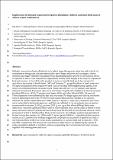Implications of farmland expansion for species abundance, richness and mean body mass in African raptor communities
Abstract
Globally, conversion of natural habitats to farmland poses the greatest extinction risk to birds, its consequences being especially pervasive in the case of large predators and scavengers, whose declines may trigger extensive cascading effects. Human population growth in sub-Saharan Africa is expected to drive a vast expansion in agricultural land by 2050, largely at the expense of pastoral land and savanna. The greatest expanse of suitable land yet to be converted to agriculture lies in East and Central Africa, including South Sudan, DRC and Tanzania. To gauge the effects of land conversion on raptor populations in this region we used road survey data from neighbouring Uganda, from which we determined linear encounter rates (birds seen 100 km−1; n = 33 species), and species richness (from 53 species). Encounter rates were much lower in pastoral land than in protected savanna (median difference: −41%; 23 species), and lower still in agricultural land (−90%; 24 species). These disparities were influenced by diet and body mass. For large eagles and vultures, encounter rates in agricultural land were 97% lower than in protected savanna (median of 12 species), whereas for smaller raptors they were 30% lower (12 species). Large, apex consumers were thus more vulnerable to farmland expansion, and this was reflected in the mean body mass of species encountered in savanna (1740 g), pastoral (995 g) and agricultural land (856 g). Body mass differences remained significant when vultures were excluded. Since threat status is linked to body mass, encounter rates for globally threatened and near-threatened species likewise showed a more pronounced deficit in farmland than those of least concern. Accordingly, pastoral and agricultural transects were less species-rich (10.6 and 6.7 raptor species 100 km−1, respectively) than savanna transects (13.2 species). Our findings suggest that the expansion of agricultural land in sub-Saharan Africa will reduce raptor populations in pastoral land and savanna by c. 50% and 90%, respectively. We propose that conservation efforts focus on identifying the causes of raptor population deficits in farmland, and on safeguarding tracts of unprotected, intact savanna, together with existing protected areas.
Citation
Shaw , P , Kibuule , M , Nalwanga , D , Kaphu , G , Opige , M & Pomeroy , D 2019 , ' Implications of farmland expansion for species abundance, richness and mean body mass in African raptor communities ' , Biological Conservation , vol. 235 , pp. 164-177 . https://doi.org/10.1016/j.biocon.2019.03.039
Publication
Biological Conservation
Status
Peer reviewed
ISSN
0006-3207Type
Journal article
Description
Funding: The cost of fieldwork was generously covered by The Peregrine Fund (USA) and the Royal Society for the Protection of Birds (UK).Collections
Items in the St Andrews Research Repository are protected by copyright, with all rights reserved, unless otherwise indicated.

